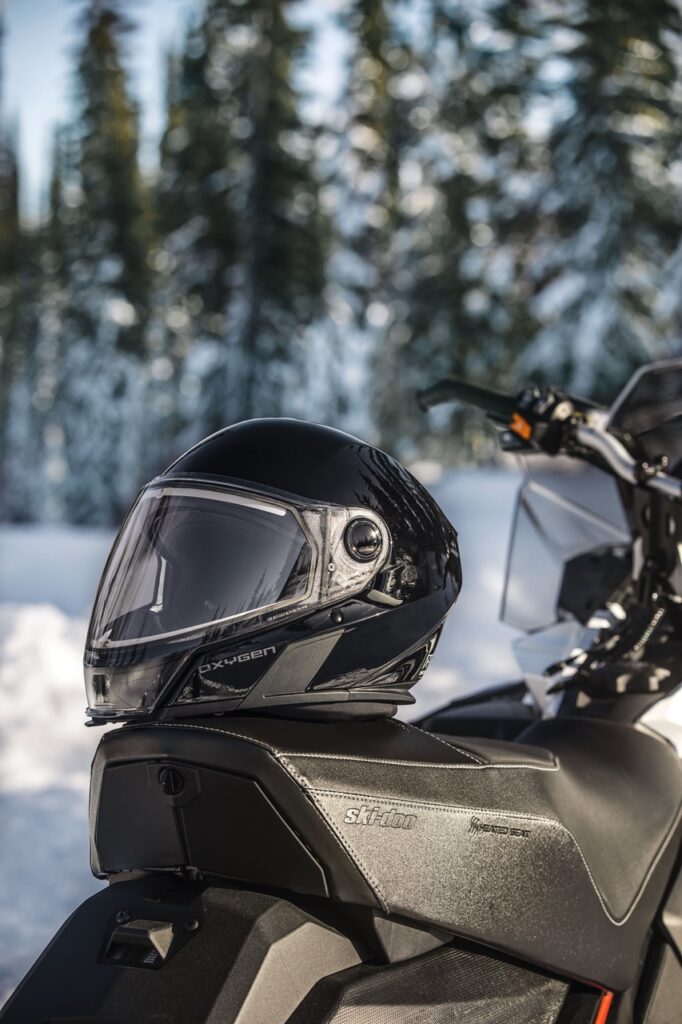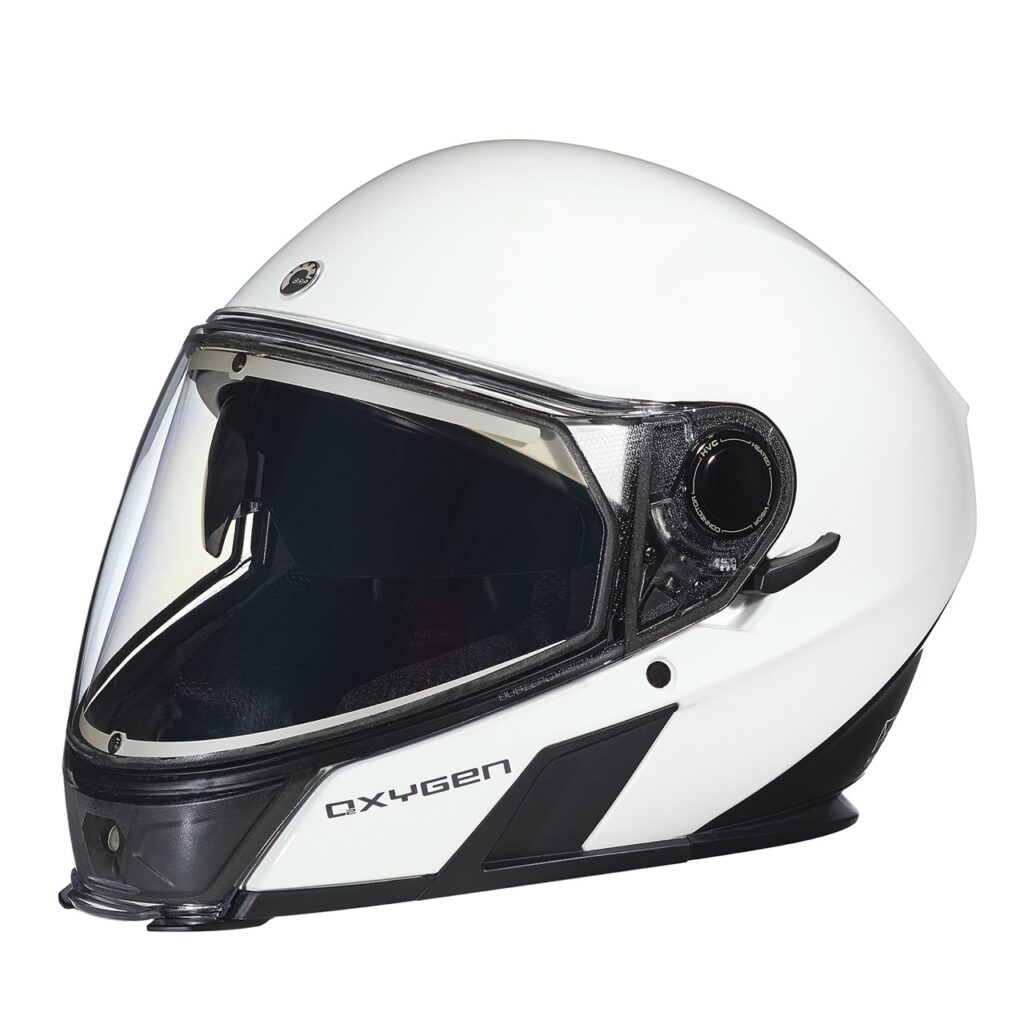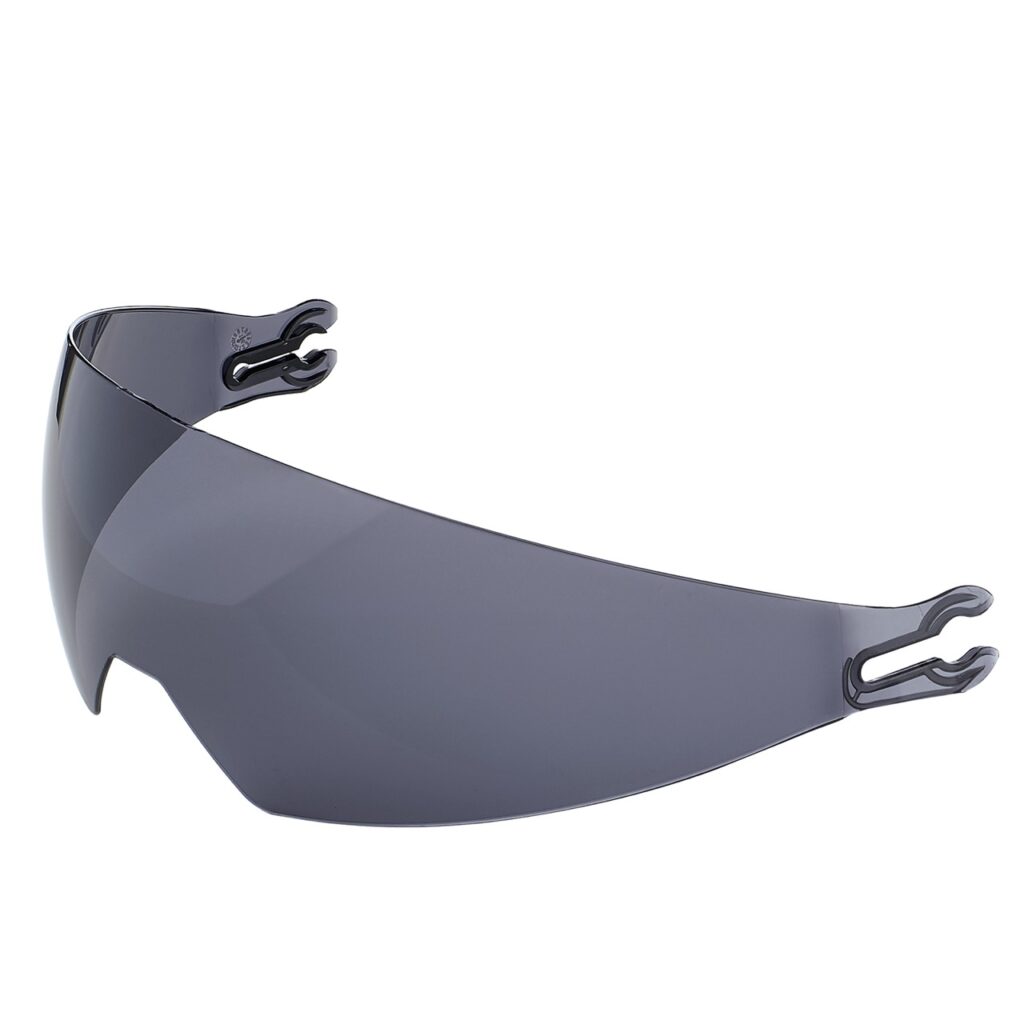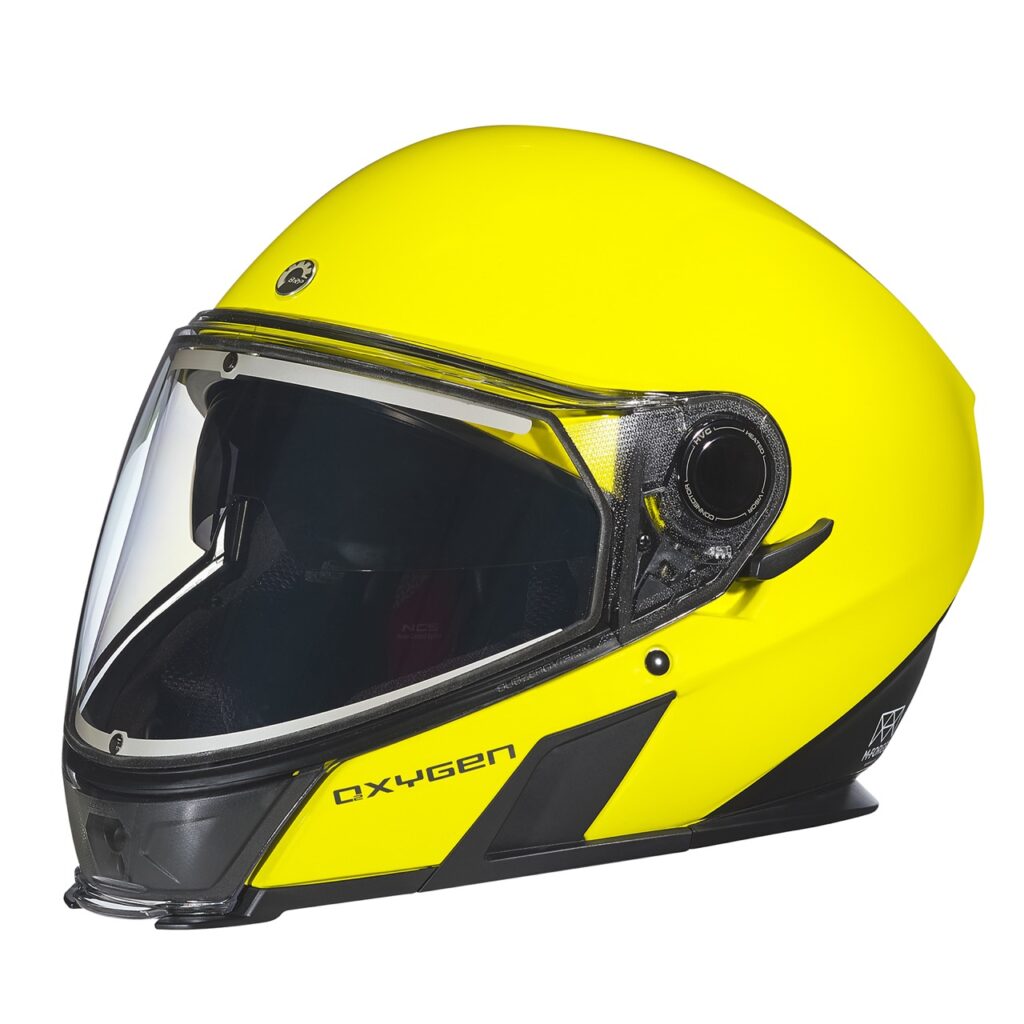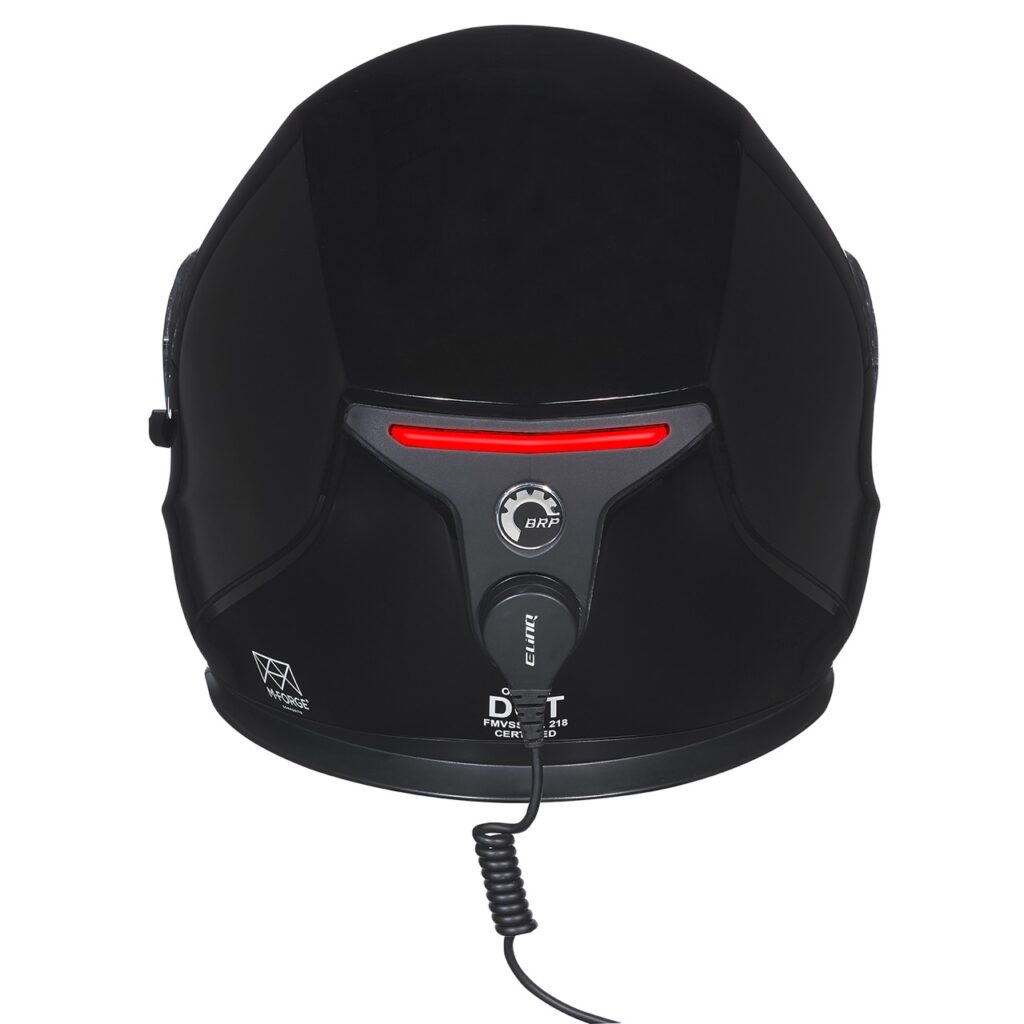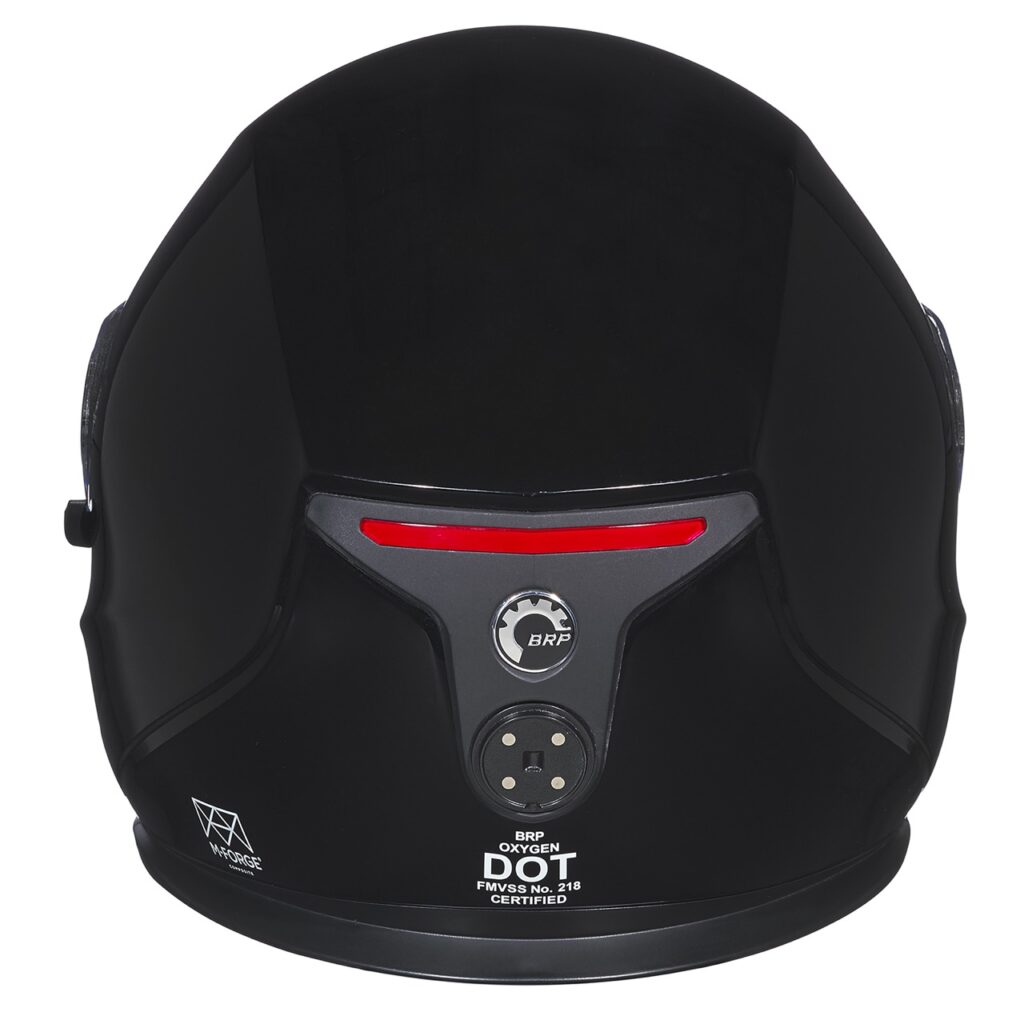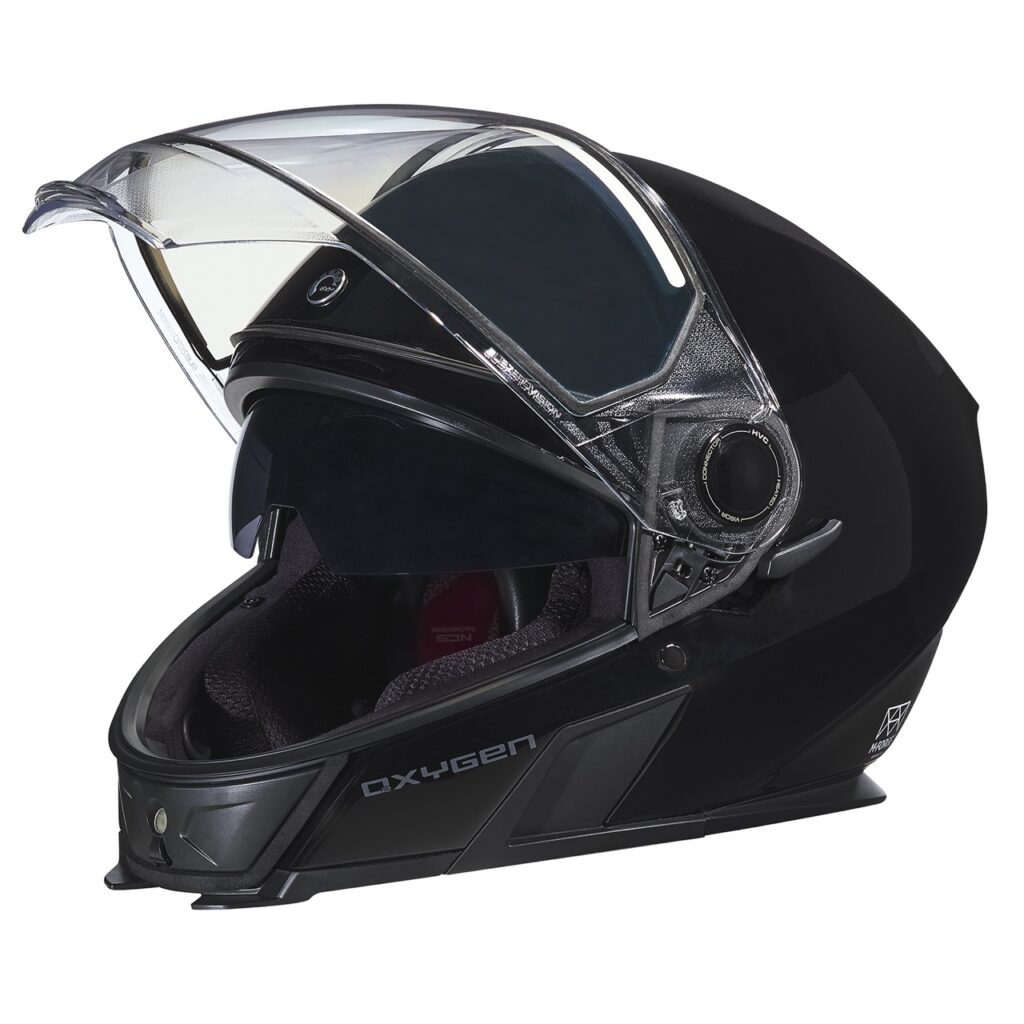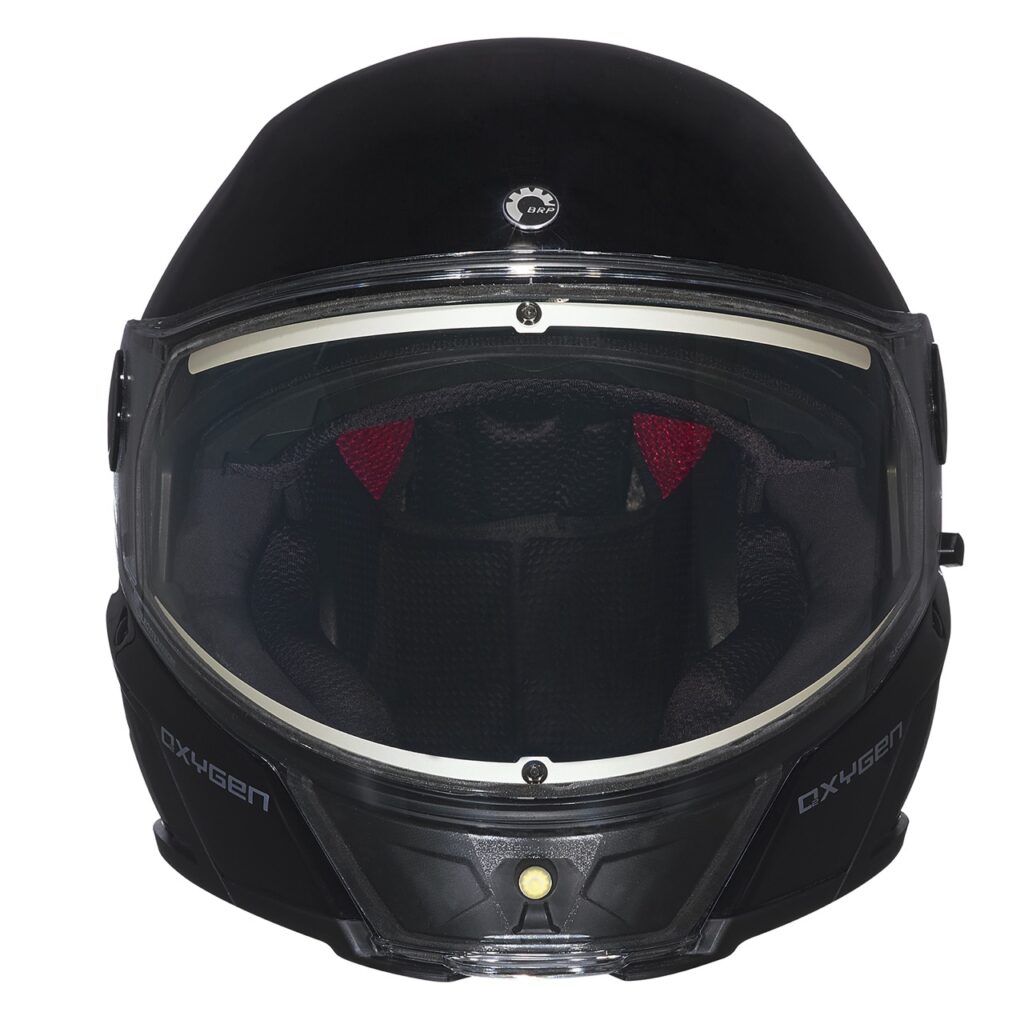New Approaches Benchmark Oxygen Snowmobile Helmet…
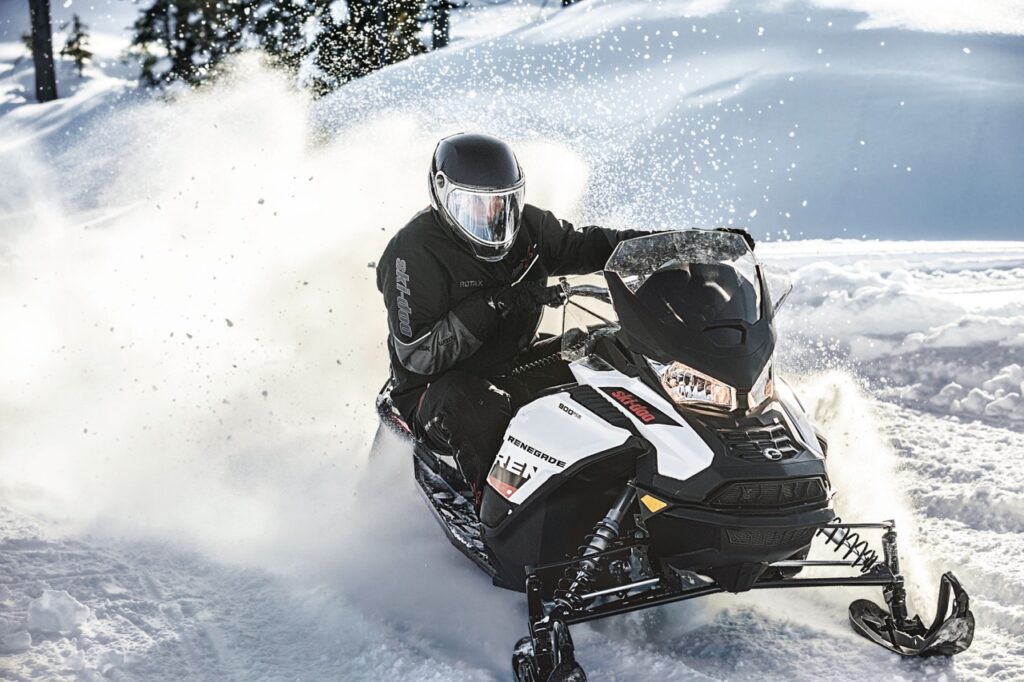
Note: The final production version of Oxygen may look slightly different from some of the prototype photos used in this review.
Related: Anti-Fogging Tips
Many snowmobilers are wondering if the Oxygen Snowmobile Helmet is right for them. That’s because a helmet can be the most frustrating part of your snowmobile gear. In fact, your head protector can make or break your ride.
At its premium price point, no wonder so many riders are asking for opinions about the Oxygen. And voicing them! So here’s mine. But fair warning, like the Oxygen Snowmobile Helmet itself, this product review covers a lot of ground and requires some time to digest…
New Concept Oxygen Snowmobile Helmet
There’s plenty to like about the sleek-looking Oxygen Snowmobile Helmet. Not least of which is the 4-year limited warranty. Meanwhile, its many impressive pluses prove BRP’s commitment to innovation, extensive research & development. And to comprehensive consumer testing.
The Oxygen is the next evolution in BRP’s mission to create the best controlled-environment snowmobile helmet for trail riders. In fact, its project name was USF, for “Ultimate Snowmobile Helmet”!
In keeping with its previous Modular & BV2S helmets, and various LinQ products, there’s no BRP/Ski-Doo branding on the Oxygen helmet. This is so that owners of all sled makes can be comfortable wearing one without compromising their primary sled loyalty. If you’re in this category, I highly recommend checking out an Oxygen helmet.
Different Approach
But be aware. The Oxygen Snowmobile Helmet is a totally new concept. It provides several new approaches. They work in combination to overcome typical challenges snowmobilers experience on the trail. And that means Oxygen owners need to think outside the box. Just like the folks at BRP did.
The Oxygen Snowmobile Helmet is high tech compared to most other snowmobile helmets. And generally, as with most things new and worthwhile, this means the Oxygen may take some individual experimenting to achieve optimal personal results. But it’s pretty straight forward once you understand how it works. And many riders will like the result. Just remember that it’s definitely not your “father’s helmet”!
Oxygen Snowmobile Helmet Overview
This was a tough review to write. It’s early days yet for Oxygen. And rider opinions are all over the map, depending on their personal experience thus far. So I’ve included a few representative comments from my Facebook page to provide a flavour of what folks are saying. For more rider opinions, check out Oxygen comments on forums such as DooTalk.
Nevertheless, here’s my take on the Oxygen Snowmobile Helmet. Many snowmobilers will love this premium lid. This will be especially true for those who take the time to pre-inform their buying decision by reading articles like this one carefully before heading to your local Ski Doo dealer.
Rider Comment: “No contest…best helmet I’ve ever had and I have had plenty over 45 plus years of sledding'” – Brian Gow
Next, before riding, review the Oxygen helmet’s comprehensive online User Guide. And then do your own testing in varying conditions. This way, you’ll have a better understanding of the Oxygen’s capabilities on the fly in the real world.
However, I’m sure that some riders will simply strap on an Oxygen and hit the trail without learning its ropes. This could result in widely differing reactions from owner to owner. But if your initial experience isn’t as expected, don’t blame a perfectly good helmet for your not knowing how it works. This would be a shame, because the Oxygen deserves your time and attention.
Rider Comment: “Love the helmet. Lighter than my BV2S, no rubber mask against my face to try and seal. Warm and quiet and the only time it ever fogged up was when I forget to attach the cord!” – Mike Keller
Expectations & Variables
Before I delve into the inner workings of the Oxygen Snowmobile Helmet, let’s chat for a moment about overall helmet expectations and variables. Certainly, most Oxygen buyers will have high expectations, at least in part based on its premium price and marketing claims.
But what you’re getting is not a miracle cure. Instead, you’re acquiring an innovative menu of premium features. When used properly and in combination, they can overcome most snowmobile helmet challenges, for most people in most circumstances.
Oxygen Snowmobile Helmet Manages Trail Riding Variables
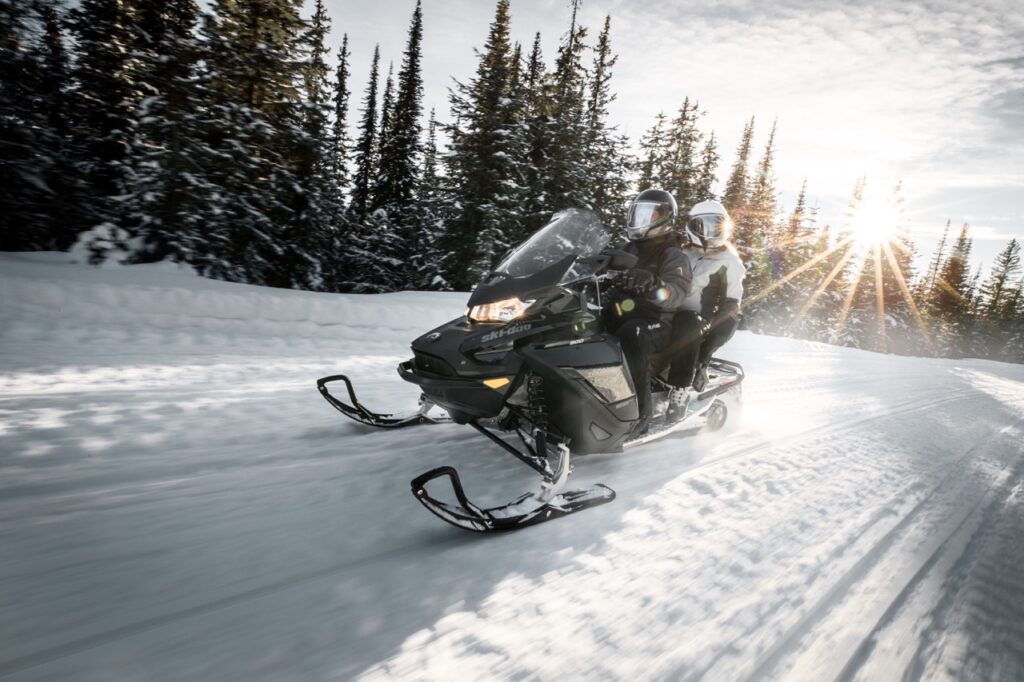
The Oxygen Snowmobile Helmet is a proactive way for riders to manage helmet difficulties. But success includes taking into account your own riding preferences and the many variables of trail riding. These may consist of:
- How much the temperature changes throughout the day.
- The amount of relative humidity in the air.
- How much and what kind of precipitation occurs during your ride.
- The height of your sled’s windshield.
- How fast you are riding or how windy it is.
- Whether you mouth or nose breathe while riding.
- How much heat your natural body metabolism normally generates.
- What additional heat your body exerts from being over-dressed, riding aggressively or digging out a stuck sled.
- How often and long you stop along the trail with your visor open or helmet off.
- Whether or not your helmet fits you properly in the first place.
- How much helmet tweaking you’re prepared to do while riding.
Ignore them at risk of visor fogging no matter how good your helmet is!
Typical Snowmobile Helmet Challenges
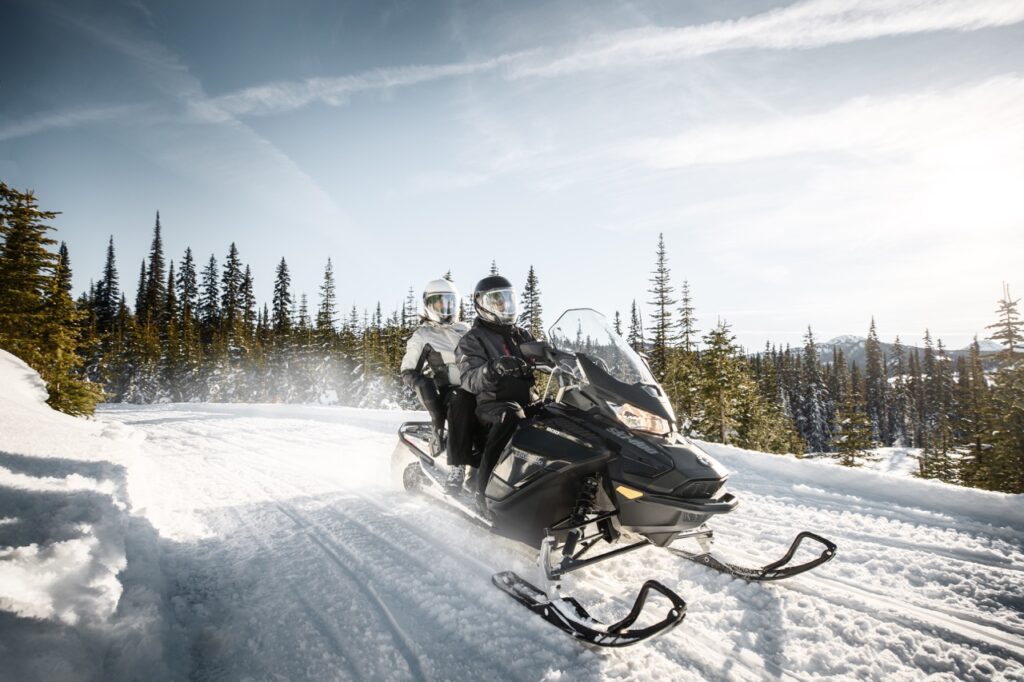
Everyone who wears a snowmobile helmet likely encounters difficulties of one kind or another over the years. Here are some of the main ones and how the Oxygen Snowmobile Helmet addresses them…
Fogging Up
The number one problem most snowmobilers have is internal visor fogging. The Oxygen Snowmobile Helmet combats impaired vision with several compatible features. They include a heated visor with variable settings control, a 16% larger heated visor area, and a rider-controlled, airflow chamber ventilation system.
Each is designed to work in combination against fogging up. Anti-fogging is also enhanced with a non-intrusive breath guard (not a mask tight to your face, see Claustrophobia below). To my knowledge, no other snowmobile helmet has all of these features with their range of anti-fogging options.
Adjustable Heat Settings
The variable settings for the Oxygen face shield provide the rider with a range of heat options. So depending on the variables mentioned above, I could adjust the visor heat accordingly. This is one of the benefits that snowmobilers need to understand and experiment with for fog control consistency throughout every ride. It’s also a big shift from other electric visors that are either on or off with no setting choices.
Adjustable Air Vents
Another feature worth testing are the integrated vents on both sides that control airflow from the outside. Once again, how you set them will depend on conditions, variables and visor heat setting.
I’ve always found successful anti-fogging to be a constant balancing act. It has to take into account all the variables mentioned previously. I think most riders who take the time to familiarize themselves with the Oxygen helmet’s anti-fogging features in various conditions will please themselves with the results, as I am.
Apparently however, a few riders experienced a visor issue in the first year when some visor panels separated to allow fogging.
Rider Comment: “On my second shield from them delineating and fogging between layers.” – Jamie Egdirtta
However, any such concern is warranty-covered and dealers provided replacements with no hassles. Meanwhile, try cranking the visor heat up high to dissipate as much of the clouding as possible. Word has it now that BRP has successfully addressed this annoying issue.
Rider Comment: “Anyone that has fogging issues, take the helmet back to dealer. Some shields are defective.” – Mike Walther
Sun Visor Fogging
Here’s another important consideration. I’ve already heard several users complain that the retractable sun visor may fog up when lowered. Such internal visors are notoriously hard to keep clear and don’t benefit from being electric.
But the Oxygen electric visor controller heats the “garage” into which the sun visor retracts. So if your sun visor starts fogging, set your visor to high. Then flip the sun visor up for a minute or two so the heat can clear it again.
Full Disclosure: I haven’t used the sun visor yet because I wear prescription sunglasses. So I’d appreciate knowing how the sun visor heating works for you!
Eyeglasses Fogging
As anyone who wears prescription eyeglasses knows, their lenses are fog magnets. They are not heated. And they sit close to your hot face and steamy breath. So even more than the helmet visor, eyeglass lenses are susceptible to fogging up. But without the same tools to combat it as for the helmet visor.
Rider Comment: “I got 500 Kms in wearing mine. Hate the price tag, love the helmet. No wind noise, super quiet and warm. Don’t like the small extension piece on the bottom of visor that is blurred out. Can’t see thru it if you like to ride with the visor partially up. I wore it with glasses a couple of times. Good news is that they don’t fog up. Best helmet I have owned.” – Dwayne Sutherland
Crack Your Visor
When my lenses started fogging inside the Oxygen on a relatively cold test day, I cracked open the face shield ever so briefly and slightly. Amazingly, I found that when doing so, the visor design prevented cold wind intrusion directly on to my face.
This is likely due to the extended piece at the centre-bottom of the face shield. It acts as the handle to raise it. But it also still diverts incoming air. Meanwhile, extra air goes to either side of centre, which helped cleared my glasses quickly. And that cold air intake didn’t seem to affect keeping my visor fog-free.
So once I got my glasses cleared, I was able to ride with the visor shut again. Since then, I’ve learned to ride with a higher heat setting and use the vents better. So have to do less visor cracking.
Rider Tip #1 – Make Sure It’s Shut
Thanks to Joel Miller for reminding to say me how important it is to fully close your visor until it clicks shut. Unless you do so, it’s possible for ice to build up around the seal on really cold days, preventing your face shield from being completely closed until any ice on the seal gets melted away.
Rider Comment: “Tried mine out today for the first time short ride around the lake so far so good and I wear prescription glasses with the vents open and visor shut after stopping and restarting my glasses defogged very quickly…looking foreword to your and others feedback.” – Bill Boychuk
Rider Tip #2 – Visor Positioning
The Oxygen face shield provides multiple raising positions that seem to click into place and stay there until moved again by the rider. This makes it easy to choose a level and then ride with your visor cracked that way for as long as you want without it shifting position..
Online Q&A
In their online Oxygen Q&A, Ski Doo carefully reports that with this new helmet “It is possible to minimize the situations or conditions that could normally generate fogging on the glasses. People who wore glasses during the customer program (who tested the helmet for more than a year) did not identify the fogging on their glasses as problematic.”
I’ve heard this from other eyeglass wearers as well. But the verdict is still out for me on this one because I’m a hot-blooded rider and heavy breather. So I want to keep testing in a wider range of temperatures. But so far, I quite pleased with how fog-free my glasses are. None the less, I’ll carry my old No-Fog Mask in my LinQ bag as back up just in case!
Rider Tip #3 – Eyeglasses
For eyeglass wearers, the lining at the temples on both sides of the Oxygen helmet has a built in channel to guide the arms of your glasses back onto your ears.
Freezing Rain
While discussing visor heat, I should also note that I didn’t encounter any freezing rain during my Oxygen product testing. But I’m told by other riders that turning the heated face shield of the Oxygen to high makes its surface hot enough to at least loosen mild to moderate freezing rain accumulation. If not melt it.
Notice that I didn’t say remove it. You still may have to use that trusty credit card to do some light removal. But it sounds like the Oxygen makes that job easier to do. With less scraping and frequency. Anyone have comments on this?
Restricted Vision
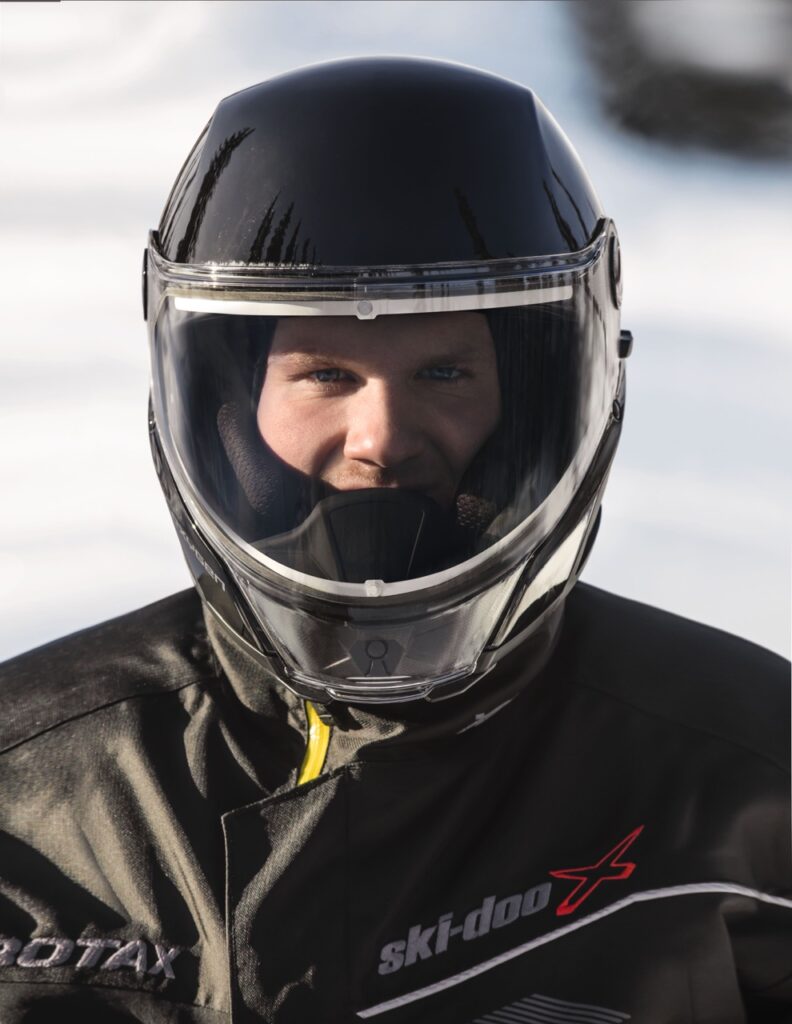
This is different from not being able to see because of fogging. Restricted vision results from a face shield area that’s not large enough to see everything you want or should see. Or from distortion caused by poor quality visor material. Both can mean you have to move your head around more than necessary trying to optimize your sight lines.
Not any more. The Oxygen helmet’s visor provides a panoramic field of vision that’s wider both side-to-side and deeper top to bottom. Combined with its enhanced clarity and zero spatial distortion, I could see more.
Plus, see it more quickly and easier than every before. Including being able to glance at the gauges without tilting my head down! In fact, with no intrusion of the helmet’s shell edges into my field of vision, I almost felt like I wasn’t wearing one at all.
This improved vision is especially beneficial at road crossings, where the Oxygen’s better peripheral sight lines are a big safety bonus for spotting oncoming vehicles.
Rider Comment: One snowmobiler mentioned a concern about riding with the visor cracked open, although this was never an issue during my testing. Apparently, he found that with the extended section at the bottom centre being slightly opaque, it restricted his vision somewhat while riding with the face shield open at a certain level.
My Previous Helmet’s Too Cold
Too many snowmobile lids can be drafty, leaving the rider uncomfortably cold. In some cases, this can even lead to frostbite on exposed flesh. My impression is that the Oxygen Snowmobile Helmet does a great job keeping face, head and front of neck warm.
Rider Comment: “Just spent 3 days 500 miles around Quebec City, L’étape, Charlevoix, amazing lid, don’t need glasses for driving but tried anyway, no fog, ear muffs dull the wind noise well and the curtain keeps the neck good without a balaclava. I had a cold back of neck Wednesday it was -22c so wore a neck sock and perfection. Best helmet I’ve ever had in my opinion. And got $250 for my gently used bv2s (I included electric visor).” – Dan Nancekivell
This warmth results from a combination of a proper fit, variable helmet visor/garage heat, excellent leak sealage, and good insulation. Plus, the Oxygen comes with a generous, integrated neck curtain with a long front piece. Tucked into the front on my jacket, this blocked chilly air from the front reaching my neck or from entering my helmet from the undersides.
One downside, however, is that on cold days I found that the inside of the neck curtain got wet from my expelled breath. Unless you can find a place to dry it out quickly at lunch, this makes for a clammy feel when re-donning the helmet.
Rider Tip #4 – Putting It On
Here’s the best way I found to put the Oxygen on without ending up with the neck curtain inside. Before starting, fold the front of the neck curtain forward toward the outside front of the helmet. Then, simply put a hand on each helmet side and with your thumbs, hold both the ends of the chin strap and the sides of the neck curtain out of the way. This prevents them from being sucked inside as your head goes into the helmet.
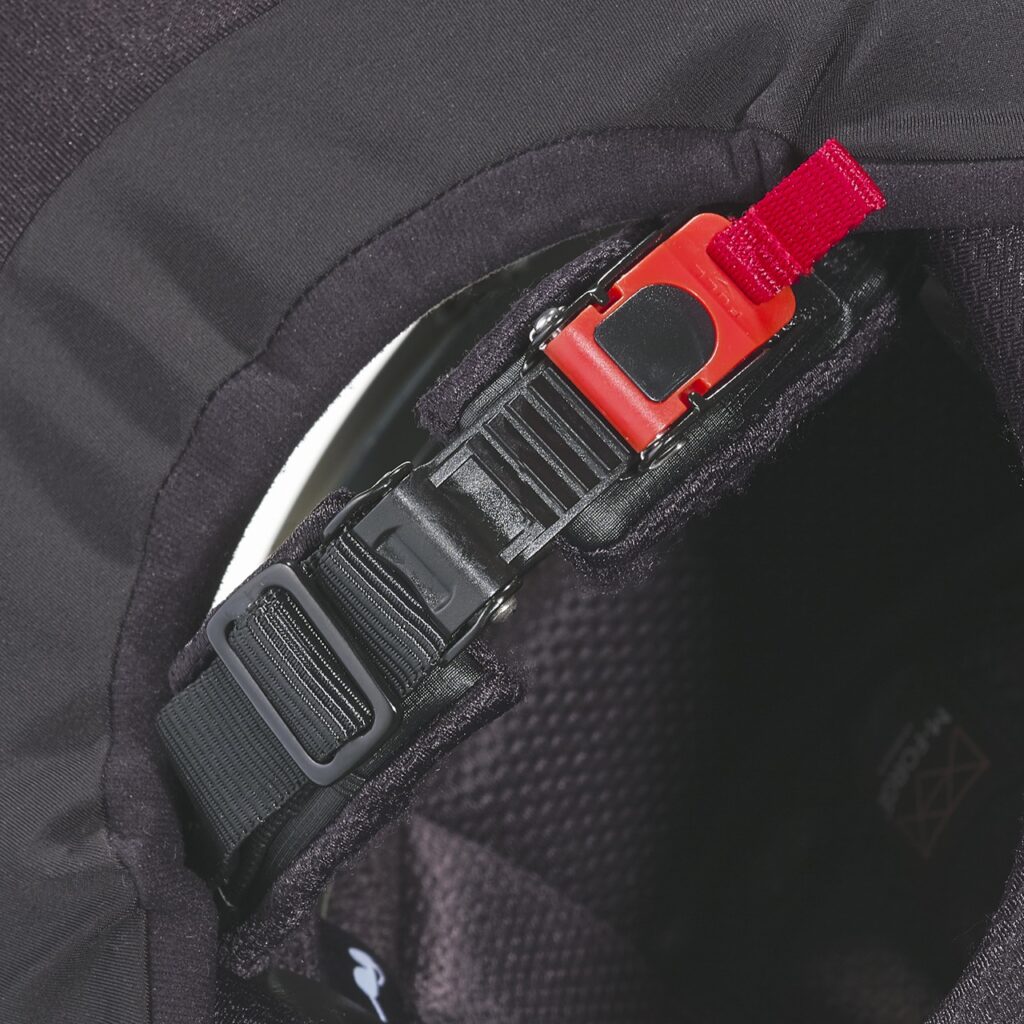
Oxygen Snowmobile Helmet fastens padded chinstraps with easy adjust & quick release Fidlock® ratcheting buckle
Rider Tip #5 – Neck Warmth
Depending on how tight and high your jacket collar is, you may still need rear neck protection from a balaclava or neck sock on deep freeze days.
My Previous Helmet’s Too Noisy

Many of the same features that combat cold also make the Oxygen Snowmobile Helmet very quiet to wear. The helmet is equipped with removable noise reduction ear pods that keep external noises to a minimum. This feature also makes the Oxygen much quieter than most other helmets for listening to your music or taking phone calls while riding. Or using helmet communicators. In fact, the Oxygen is even set up to easily accommodate the installation of ear speakers and a voice mic.
Meanwhile, anyone who doesn’t want as much noise reduction can simply remove the ear pods completely and still have a very quiet lid. I took mine out because I was better able to position my glasses on my ears without them.
Another important note is to make sure your Oxygen visor actually seals completely into place with an audible click when closing it. Even if you need two hands to do it. If not, you may get unwanted external wind noise and also a cool draft. In my experience, getting this shut properly makes a big difference to your helmet’s functionality.
Rider Tip #6 – Helmet Sizing
You want a helmet to fit snuggly, but comfortably without moving independently on your head. If one size of the Oxygen feels a little tight around the side and ears, but the next larger size is too big, try tweaking the Oxygen ear pods (see online user guide). They can be easily made thinner to ease up on ear pinch. Or if necessary, remove them entirely to optimize fit.
One thing to remember though, is that the noise reduction ear pods also help anchor the Oxygen on your head. This prevents any sense of helmet shift from excess air blast at higher speeds.
My Previous Helmet’s Too Claustrophobic
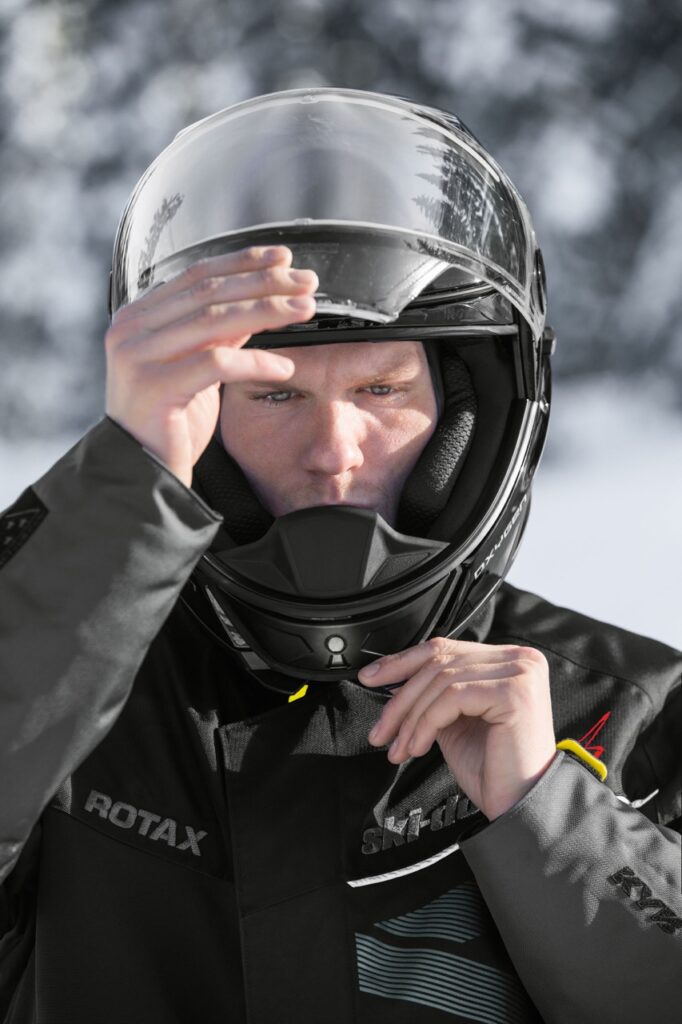
Some riders never got accustomed to the breath masks on the Modular and BV2S helmets. Many found these tight masks against their faces irritating, distracting, restricting and even yucky. But the Oxygen Snowmobile Helmet is mask-free. So there’s nothing against your face unless you put it there, not even the integrated breath guard.
Combined with the huge field of vision provided through its face shield, the Oxygen Snowmobile Helmet is the least confining head protector I’ve ever worn. Plus, I could talk or snack with my helmet on!
My Previous Helmet’s Too Heavy
Although it’s never been an issue for me, some riders complain about sore necks from their too-heavy helmets. But I can see where this might be a concern for smaller or less strong riders. The Oxygen Snowmobile Helmet puts less strain on a rider by using lightweight M-FORGE® Composite for the shell. It meets the same international safety standards as traditional helmet materials. But it’s up to 20% lighter than carbon fibre and up to 30% less than other traditional shells.
Rider Tip #7 – Less Neck Strain
The Oxygen’s aerodynamic styling means less wind drag on the helmet. Combined with its lighter weight, this means less neck strain for the rider.
My Visor Cord Gets in The Way
Traditional heated electric visors plug in at the left side of the helmet and at the machine. On occasion, I’ve had mine yanked by an errant branch on a too-narrow trail. I’ve also forgotten to unplug it when getting off the sled, had a plug come loose in transit, and even stepped on a dangling plug end. What’s worse is trying to figure out whether the visor’s on or not from some tiny pilot light where the cord plugs into the helmet. Have you ever tried to spot that pinprick light on a blazing sunny day?
Changing The Equation #1: Magnetic Connector
The Oxygen Snowmobile Helmet changes the equation for powering your visor. First, the cable connection is out of the way at the back of helmet. The helmet end of this special eLinQ cable has a magnetic connector, not a plug in. It snaps into place easy as pie, even with gloves on. But it’s strong enough not to shake loose while riding. Just remember to disconnect eLinQ before removing either your helmet or jacket!
Changing The Equation #2: Re-Routed Power Cable
The second equation change for powering your visor is cable re-routing. The special Oxygen cable is intended to run down into the inside back of your jacket through the loop at the collar for hanging it up. From there, you can route it inside along your right or left side. Or between your jacket’s outer shell and removable liner if you have one.
As shown above, the other end of the Oxygen cable has the variable heat controller. It clips to the external plastic loop on your jacket for attaching your tether cord. So it’s secured to your jacket and also visible more to check for power than a pin light on the side of your helmet. Plus, the power cable’s in a relatively handy position to change visor temps, although I found this requires stopping momentarily.
This new routing for the visor cable keeps it protected inside your jacket and out of the way. And there, it just stays in place whether you’re wearing the coat or hanging it up at a restaurant or at day’s end. Just remember to disconnect the magnetic end from your helmet before removing it or taking your coat off.
Changing The Equation #3: Standard Cord
Now for the third equation change. From your jacket to the plug in on your sled, the Oxygen uses a standard connector cord. You can unplug it at your jacket and leave it on the sled when you’re getting off. This way, there’s no dangly cord on your person when you’re not on your sled. Yes, unfortunately you still have to remember to disconnect & reconnect it from the sled!
Changing The Equation #4: Rear Light
And the fourth equation change is that the power from your sled’s battery that heats your visor also lights up an integrated red safety light located at the upper back of your helmet. No more having to change the batteries for this handy light as with a BV2S helmet.
So whenever you’re plugged in, riders behind can easily pick out your red light to follow. Obviously, this really stands out at night. But riders following me could even see it easily in daylight snow dust on my product test ride. Plus, this light being on is another way to confirm you’ve got visor power!
At first, I didn’t fully appreciate the benefit of having this red light on at all times. But then my riding companions started raving about how easy it was to see and follow. So now I know that my Oxygen makes trail riding easier and safer for my buddies too!
However, there is one downside to this rear light. It’s always lit up, with no on or off switch. So as rider Rich Bono reports, it’s a pain for passengers riding 2-up behind an Oxygen helmet wearer. They’re always confronted with a bright light just a few inches in front of their face. Apparently, the only solution on offer is the cover the rear light with duct tape when doubling up.
Rider Tip #8 – Cords & Outlets
With any electric visor set up, I’m nervous about broken cords. So I always carry a spare. Spare eLinQ power cables are available for the Oxygen Snowmobile Helmet. These are the ones with the integrated magnet connector at one end and the variable heat controller at the other. Personally, I wouldn’t ride without a spare just in case there’s an issue on a tour and I can’t get another quickly.
Linda Miller also noted in a comment that it’s a good idea to make sure that your spouse’s sled has a heated visor power outlet. This way, if you ever switch sleds, you can plug in your Oxygen helmet. It’s also a good idea to make sure you carry extra power outlet fuses just in case,
Is The Oxygen A Modular Helmet?
Certainly, the Oxygen visor is large enough that when raised up, more of your face is exposed than with available fixed-face or snocross-style lids. This feature makes conversation, snacking and face cooling easy without helmet removal. And it’s also handy for smokers. There’s even enough room to get the viewfinder from compact camera to your eye.
But by definition, a “modular helmet” allows the front of the helmet to be lifted up or down out of the way so your face is totally exposed. The Oxygen does not do this. That may take some getting used to for some riders who are used to this key modular feature.
On the other hand, if you’re already a fixed-face helmet wearer, no problem. You should be very satisfied (Dare I say surprised!) with how open the Oxygen snowmobile helmet is with the face shield fully raised.
Oxygen Snowmobile Helmet Verdict
Let’s end with a few words about the Ski Doo Modular and BV2S helmets. Each of these proven head protectors have won fans among many snowmobilers. Their face masks have kept many a visor fog-free, often without the use of an electric visor or of a cord that tethers you to your sled. As such, both are still viable options in the war against fog.
But some of us can’t stand face masks. Or have face shapes that aren’t conducive to getting a good face mask seal. Or simply want to see more. And a time will also come when you need a new helmet. Plus, the BV2S has earned a bit of a reputation for not being as simple to use as many riders would like.
Oxygen Alternative
For these and the many other reasons mentioned, the Oxygen Snowmobile Helmet is a welcome and valuable asset to any rider’s arsenal of proactive fog control measures. Initially, it will appeal to early adapters and the more technically inclined. Also, to riders who want the latest and greatest. And those who love spending money on snowmobiling. But I’m also betting many others will wait and see what the scuttlebutt is this winter before opening their wallets.
It’s important to note that the Oxygen Snowmobile Helmet totally relies on your sled battery to power its various ant-fogging benefits. Not unlike other electric visor helmets, this means you must always be connected to your sled via the power cord while riding. So if you simply can’t get used to riding with a cord or already have a good way of riding fog-free without a heated visor, the Oxygen may not be for you.
Rider Comment: “I’ve been using the BV2S without a heated visor with 99% success. I hate plugging and unplugging visor cords and having them short out from time to time. Once you get used to the breath box on the BV2S, it’s pretty tough to beat.” – Kevin Barr
Work To Be Done
To date, rider feedback remains mostly very positive. In part, that’s because Ski Doo assembled a group of avid snowmobilers to be Oxygen Helmet Development Program Testers BRP during development. BRP even challenged the Oxygen Snowmobile Helmet to deliver during one on the world’s most gruelling snowmobile endurance races!
With their continual and independent input, BRP set out to make a lighter-weight, mask-free and quieter helmet. The Oxygen product team succeeded on all counts because each of these factors was within their control.
Rider Comment: “This is my 4 year using I ride about 3000 km a year I was on test program I’m now using a purchased helmet I found by far the best helmet ever.” – Jeff Berg
However, the BRP mission also included taking anti-fogging to the next level. And many new Oxygen owners were happy with the result. Plus, now that BRP has resolved the 1st-year visor issue, the Oxygen’s winning many more converts. What’s more, I’m also willing to bet that even more Oxygen innovations are on the way sooner than later!
Rider Comment: “I love mine but still not sure how everything works I am very interested in this article” – Michelle Rouleau
Last Word
Hopefully, most of us will be among the happy Oxygen wearers. We’ll take the time and make the effort to find our own Oxygen sweet spot for a fog-free experience. The Oxygen Snowmobile Helmet is more than capable of delivering excellent anti-fogging when all parts sync in unison. And if used properly by riders. When that happens, Oxygen will quickly become your ultimate snowmobile helmet! That’s why it made my list of game changer snowmobile products!
- Price in Canada: $774.99
- Price in US: $599.95
Check out more product reviews!
The tips and advice in this blog are the opinions of the author, may not work in every situation and are intended only for the convenience and interest of the reader, who has the personal responsibility to confirm the validity, accuracy and relevancy of this information prior to putting it to their own use.

